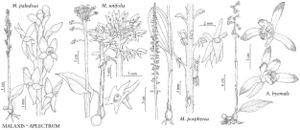Malaxis paludosa
Kongl. Vetensk. Acad. Nya Handl. 21: 235. 1800.
Plants 3–23 cm. Roots fine. Pseudobulbs 4–8 mm diam. Leaves 2–3, basal; blade elliptic or narrowly elliptic, 0.3–3.5 × 0.1–1.5 cm. Inflorescences spicate racemes, 0.5–9 cm; floral bracts lanceolate, 1.4–3.3 mm; pedicels 2–3 mm. Flowers 2–55, not resupinate, green or yellowish green; dorsal sepal ovatelanceolate, (1.6–) 2–2.5 × 1–1.6 mm, apex acuminate; lateral sepals reflexed, elliptic, falcate, (1.6–) 2.5 × 1–1.6 mm, apex acuminate; petals strongly recurved, ovatelanceolate, 1.4–1.9 × 0.5–1 mm, apex acuminate; lip ovate with dark green veins, 1.2–1.8 × 0.7– 1 mm, base cuneate, apex unlobed, acuminate; column (0.3–) 0.5–0.7 × (0.3–) 0.5–0.7 mm; pollinia yellow. Capsules ascending, ellipsoid, 4 × 2 mm. 2n = 28.
Phenology: Flowering summer.
Habitat: Open sphagnum bogs, swampy woods
Elevation: 10–300 m
Distribution
Alta., B.C., Man., N.W.T., Ont., Sask., Yukon, Alaska, Minn., Eurasia
Discussion
Malaxis paludosa sometimes reproduces asexually by production of gemmae on the leaf tips (R. L. Taylor 1967).
Selected References
None.
